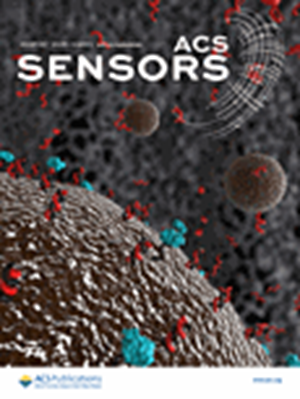基于电纺丝CeO2/CuO纳米管的电导硫化氢传感器的耐湿性和氧含量独立性分析
IF 8.2
1区 化学
Q1 CHEMISTRY, ANALYTICAL
引用次数: 0
摘要
由于固有的物理化学性质和表面吸附为主的气敏行为的限制,传统的金属氧化物在测试环境中容易受到环境湿度水平和氧含量的影响。为了克服这个问题,我们提出了一种高灵敏度的mems型H2S传感器,该传感器采用电纺丝氧化铈(CeO2)/氧化铜(CuO)纳米管作为传感层。组成比优化的传感器(CeO2/CuO-5)比纯CeO2传感器具有更优越的h2s传感性能,包括更低的工作温度,两倍以上的响应(7.4 vs 3.1@4 ppm)和良好的选择性。密度泛函理论计算和一系列表征方法发现,增加的氧空位和丰富的CeO2/CuO n-p异质结共同促进了受体和换能器的功能。此外,还证明了抗湿度和不依赖氧含量的传感器性能。一方面,CeO2的自刷新效应使CeO2/CuO-5传感器在70% RH条件下对4 ppm H2S的响应保持率比干燥情况下的75.6%,从而表现出优异的耐湿性。另一方面,CeO2良好的储氧能力有利于在贫氧环境下的高响应。在此基础上,设计了装有传感器的巡逻监测装置,对现场H2S泄漏进行了有效的检测和报警。本文章由计算机程序翻译,如有差异,请以英文原文为准。

Deciphering the Humidity Resistance and Oxygen-Content Independence of Conductometric Hydrogen Sulfide Sensors Based on Electrospun CeO2/CuO Nanotubes
Limited by inherent physicochemical properties and surface-adsorption-dominated gas-sensing behavior, traditional metal oxides are susceptible to ambient humidity levels and oxygen content within test environments. To overcome this issue, we proposed one highly sensitive MEMS-type H2S sensor featuring electrospun cerium oxide (CeO2)/copper oxide (CuO) nanotubes as the sensing layer. The constituent ratio-optimized sensors (CeO2/CuO-5) exhibited superior H2S-sensing performance over pure CeO2 counterparts, including lower operation temperature, more than two times stronger response (7.4 vs 3.1@4 ppm), and favorable selectivity. Density functional theory calculations and a series of characterization methods found that the increased oxygen vacancies and abundant CeO2/CuO n-p heterojunctions jointly contributed to the promotion of receptor and transducer function. In addition, a humidity-resistant and oxygen content-independent sensor performance was demonstrated. On the one hand, the self-refreshing effect of CeO2 endowed the CeO2/CuO-5 sensor with 75.6% retention of response toward 4 ppm of H2S under 70% RH with respect to the dry case, thus showcasing an excellent humidity tolerance. On the other hand, the decent oxygen storage ability of CeO2 favored a high response even under oxygen-lean environments. Furthermore, a patrol monitor apparatus loaded with the as-prepared sensor was designed, which showed efficient detection and alerting for on-site H2S leakage.
求助全文
通过发布文献求助,成功后即可免费获取论文全文。
去求助
来源期刊

ACS Sensors
Chemical Engineering-Bioengineering
CiteScore
14.50
自引率
3.40%
发文量
372
期刊介绍:
ACS Sensors is a peer-reviewed research journal that focuses on the dissemination of new and original knowledge in the field of sensor science, particularly those that selectively sense chemical or biological species or processes. The journal covers a broad range of topics, including but not limited to biosensors, chemical sensors, gas sensors, intracellular sensors, single molecule sensors, cell chips, and microfluidic devices. It aims to publish articles that address conceptual advances in sensing technology applicable to various types of analytes or application papers that report on the use of existing sensing concepts in new ways or for new analytes.
 求助内容:
求助内容: 应助结果提醒方式:
应助结果提醒方式:


